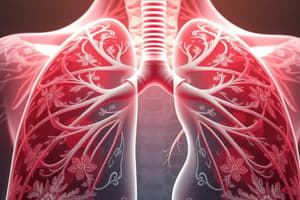Podcast
Questions and Answers
What is dyspnea?
What is dyspnea?
Shortness of breath
The most common form of COPD is ________. (Select one)
The most common form of COPD is ________. (Select one)
- Asthma
- Bronchitis
- Emphysema (correct)
- Pneumonia
A ________ is a collection of fluid between the lung and chest wall that may compress the lung.
A ________ is a collection of fluid between the lung and chest wall that may compress the lung.
Pleural effusion
Decreased, absent, or abnormal breath sounds are also called vesicular breath sounds.
Decreased, absent, or abnormal breath sounds are also called vesicular breath sounds.
Adult patients breathing more than 20 breaths/min or fewer than 12 breaths/min should receive high-flow oxygen.
Adult patients breathing more than 20 breaths/min or fewer than 12 breaths/min should receive high-flow oxygen.
Snoring sounds are indicative of a partial lower airway obstruction, usually in the bronchioles.
Snoring sounds are indicative of a partial lower airway obstruction, usually in the bronchioles.
Which of the following medications can be used for the treatment of an acute asthma attack? (Select one)
Which of the following medications can be used for the treatment of an acute asthma attack? (Select one)
What is the most appropriate method for oxygen delivery to an adult patient experiencing breathing difficulty? (Select one)
What is the most appropriate method for oxygen delivery to an adult patient experiencing breathing difficulty? (Select one)
When assisting an asthmatic patient with a small-volume nebulizer attached to oxygen, what is the appropriate flow rate for the oxygen? (Select one)
When assisting an asthmatic patient with a small-volume nebulizer attached to oxygen, what is the appropriate flow rate for the oxygen? (Select one)
In addition to asthma, which of the following conditions is associated with wheezing? (Select one)
In addition to asthma, which of the following conditions is associated with wheezing? (Select one)
What is atelectasis? (Select one)
What is atelectasis? (Select one)
Which type of breath sound are you more likely to hear in a person with congestive heart failure? (Select one)
Which type of breath sound are you more likely to hear in a person with congestive heart failure? (Select one)
What condition do the findings of anxiety, tachycardia, blue fingertips and lips, frothy sputum, and crackles indicate in a woman in her early 60s? (Select one)
What condition do the findings of anxiety, tachycardia, blue fingertips and lips, frothy sputum, and crackles indicate in a woman in her early 60s? (Select one)
In the mnemonic PASTE, what does the 'S' stand for? (Select one)
In the mnemonic PASTE, what does the 'S' stand for? (Select one)
Flashcards are hidden until you start studying
Study Notes
Respiratory Emergencies Overview
- Dyspnea refers to shortness of breath, a common symptom in respiratory distress.
- The most prevalent form of Chronic Obstructive Pulmonary Disease (COPD) is Emphysema.
Common Conditions
- Pleural Effusion is a fluid collection between the lung and chest wall that can compress the lung.
- Adventitious Breath Sounds are abnormal or decreased breath sounds, not to be confused with vesicular breath sounds.
Breathing Rates and Treatments
- Adult patients breaching a respiratory rate of over 20 breaths/min or fewer than 12 breaths/min should receive high-flow oxygen.
- Snoring sounds indicate a partial upper airway obstruction, typically in the oropharynx.
Medications for Asthma
- Albuterol is a key medication used during an acute asthma attack.
- For oxygen delivery in adults with breathing difficulties, the nonrebreathing mask at 15 L/min is most appropriate.
Nebulizer Assistance
- The optimal flow rate for oxygen when assisting an asthmatic patient with a small-volume nebulizer is 6 L/min.
Wheezing Conditions
- Conditions associated with wheezing include asthma and Bronchitis.
Atelectasis and Breath Sounds
- Atelectasis is defined as the collapse of alveolar air spaces in the lungs.
- In congestive heart failure, crackles are the expected abnormal breath sounds.
Clinical Signs & Conditions
- A patient presenting with anxiety, tachycardia, cyanosis, cough with frothy sputum, and crackles may indicate Congestive Heart Failure.
Mnemonic PASTE
- In the mnemonic PASTE, "S" stands for Sputum.
Studying That Suits You
Use AI to generate personalized quizzes and flashcards to suit your learning preferences.




